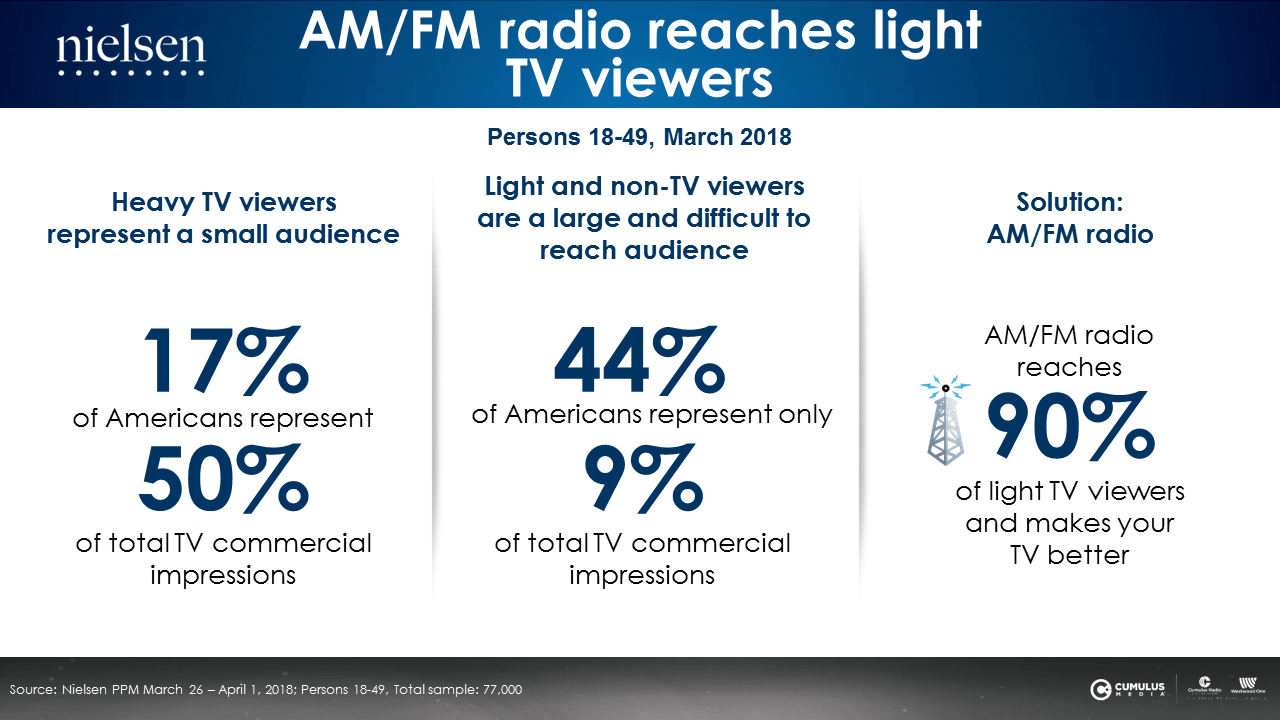AM/FM Radio Reaches America’s Light TV Viewers
What percentage of your TV impressions come from light TV viewers? How can AM/FM radio make your TV better?
First-ever TV and radio cross media study
Westwood One commissioned a first-ever Nielsen cross media audience study of television and AM/FM radio. Nielsen utilized its 80,000 person Portable People Meter panel that measures both television and AM/FM radio audiences. Nielsen examined TV time spent among heavy TV viewers as well as light and non-TV viewers.
The key finding: Light and non-TV viewers represent a large percentage of the TV audience but represent only a small percentage of TV time spent and commercial impressions.

A heavy lesson in heavy TV viewers: Among persons 18-49, 17% are heavy TV viewers and they represent half of all TV impressions. So half of your TV ad impressions come from 17% of America.
Light and non-TV viewers: A significantly larger percentage, 44%, of persons 18-49 fall into the light and non-TV viewer group. Despite their substantial size, light TV viewers only represent 9% of total TV commercial impressions. 44% of America represents only 9% of your TV ad impressions.
AM/FM radio makes TV campaigns better by reaching light TV viewers
AM/FM radio, the number one mass reach medium, is the solution for advertisers who need to reach the light TV viewer. AM/FM radio reaches 90% of light TV viewers. A small reallocation of a TV media plan to AM/FM radio can result in a significant lift in campaign reach in addition to driving growth in brand awareness, consideration, and purchase.
At the recent Nielsen 360 conference, Roger Adams, former Chief Marketing Officer of USAA, The Home Depot, and Lord and Taylor, Executive Director of Advertising and Marketing at General Motors, and current Principal Consultant at Pragmax LLC, discussed how AM/FM radio amplifies TV. He outlined how AM/FM radio campaigns were often developed with the “same objectives, same basic message, but a little bit greater length, a little more specificity than the TV campaign.”
To Adams, TV and AM/FM radio are complementary in the media plan. When describing campaigns that ran during his tenure as CMO at The Home Depot, Adams explained, “If we didn’t run radio, we did not get the foot traffic we were looking for.” AM/FM radio was essential in achieving the campaign results.
Advertisers can’t solve the light TV viewer problem by buying more TV
Spending more on TV to reach light TV viewers only results in more exposure to heavy viewers. Allocating a portion of the media budget into AM/FM radio adds incremental reach. Instead of the messaging being concentrated on heavy TV viewers watching at night, AM/FM radio reaches the audience who is out and about during the day. AM/FM radio is the daytime soundtrack of the American worker.
AM/FM makes your TV better
TV and AM/FM radio work as a team. Adams agrees, likening media plans to investments: “You want a portfolio of different media types so that you can maximize your return…Adding radio to a TV-only plan using a constant budget adds TRPs, reaches light TV viewers, and delivers better ROI.” Television has mass scale but needs AM/FM radio to reach light viewers and to boost branding and campaign impact.
AM/FM radio reaches all light TV viewer demographics:
- Teens: 44% of persons 12-17 represent only 9% of total TV commercial impressions. AM/FM radio reaches 88% of this audience.
- Millennials 18-34: 45% of persons 18-34 represent only 7% of total TV commercial impressions. AM/FM radio reaches 89% of this audience.
- Persons 25-54: 44% of persons 25-54 represent only 10% of total TV commercial impressions. AM/FM radio reaches 92% of this audience.
- Boomers 55+: 41% of persons 55+ represent only 17% of total TV commercial impressions. AM/FM radio reaches 93% of this audience.
Click here to read full coverage on MediaPost.
Pierre Bouvard is Chief Insights Officer at Cumulus | Westwood One.
Contact the Insights team at CorpMarketing@westwoodone.com.